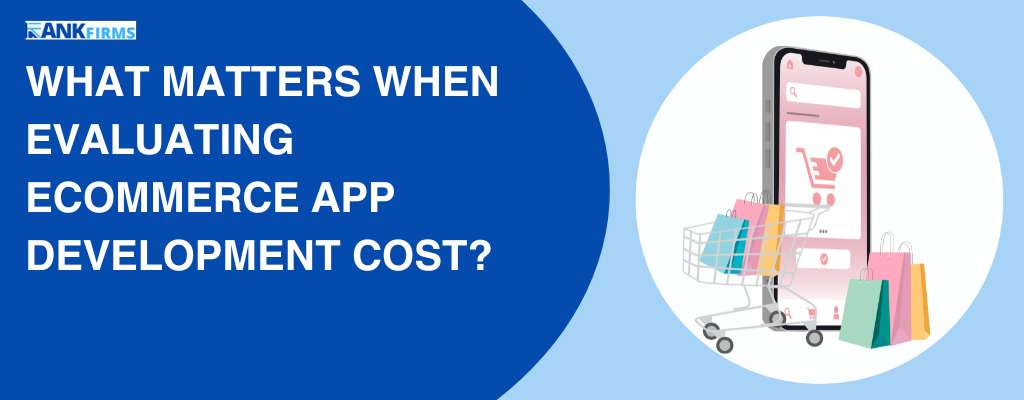We can’t think of our lives without our mobile devices. These compact powerhouses have been seamlessly integrated into our lives controlling how we live, work and shop. They not only offer us immediate access to information, they also help us communicate and manage finances hassle-free. From checking emails to scheduling appointments to ordering groceries, to browsing, these handheld devices offer on-the-go simplified management.
Just like any other business, eCommerce business is also affected by the advancement of these handheld devices. Now eCommerce has turned into 24X7 activity where user is leveraged to browse and shop day and night. What makes a few eCommerce outshine is its unique and intuitive interfaces. The improvements in screen resolutions, reliable internet and faster processors in mobiles are catering for convenience and immediacy for online activity.
Constant connectivity and accessibility are a convenience, however, personalized product recommendations are playing a major part in daily routines and online shopping habits. Features like wishlists, product filtering, and secure payment make them captivating while boosting mobile commerce sales. Additionally, social media platform integration offers seamless product discovery enhancing the overall shopping experience and shaping a more digital and on-the-go lifestyle.
This article contributes to the development of the eCommerce application. Entrepreneurs who want to invest in eCommerce or Store owners wanting to expand their business online must know a few things before making that decision. We will help you evaluate online store development cost keeping necessary factors in mind.
Step-by-Step Process for Developing an eCommerce Application
Step 1: Define Business Goals and Objectives
What to do: Identify your target audience, business model (B2B, B2C, or marketplace), and unique selling proposition.
Why it matters: This ensures the app aligns with your business strategy and meets user expectations.
Step 2: Conduct Market Research
What to do: Analyze competitors, trends, and customer pain points.
Why it matters: Helps you identify gaps and features that will make your app stand out.
Step 3: Choose the Right Development Approach
Options:
- Custom Development: Tailored solutions with full control.
- Pre-built Platforms: Quicker deployment using platforms like Shopify or Magento.
- Hybrid: Combines the benefits of both.
Why it matters: Your approach affects cost, scalability, and time-to-market.
Also Read: Top 10 FAQs Before Hiring eCommerce Development Company
Step 4: Plan the App Features and Functionalities
Essential Features:
- User Registration & Profiles
- Product Catalog with Search & Filters
- Shopping Cart & Checkout
- Secure Payment Gateway Integration
- Order Tracking
- Push Notifications
- Customer Support (Chatbots or Live Support)
Advanced Features:
- AR/VR Product Previews
- AI-Powered Recommendations
- Multi-language & Currency Support
- Social Media Integration
Why it matters: Prioritizing features ensures a seamless user experience.
Step 5: Select the Tech Stack
Frontend: React.js, Angular, or Vue.js.
Backend: Node.js, Ruby on Rails, or Python.
Database: MySQL, MongoDB, or PostgreSQL.
Cloud Hosting: AWS, Azure, or Google Cloud.
Why it matters: The tech stack influences performance, scalability, and maintenance costs.
Step 6: Design the User Interface (UI) and Experience (UX)
What to do: Create wireframes and prototypes with user-friendly navigation and a clean layout.
Why it matters: A visually appealing and intuitive design enhances user engagement and retention.
Step 7: Develop the App
Frontend Development: Build the visual components and interactivity.
Backend Development: Implement core functionalities like database management, APIs, and server-side operations.
Integration: Link the app to third-party services like payment gateways, logistics APIs, and analytics tools.
Why it matters: Ensures all features work cohesively for a seamless experience.
Step 8: Test the Application Thoroughly
Types of Testing:
- Functional Testing: Ensures features work as intended.
- Performance Testing: Checks speed and reliability under heavy loads.
- Security Testing: Protects against vulnerabilities like data breaches.
- Usability Testing: Verifies user-friendliness.
Why it matters: Testing minimizes bugs and ensures a polished product at launch.
Step 9: Deploy the App
What to do:
- Host the app on cloud servers.
- Publish it on relevant platforms (App Store, Google Play, or web).
- Implement version control for smooth updates.
Why it matters: A successful deployment ensures accessibility to users.
Step 10: Monitor and Maintain the App
What to do:
- Track performance with analytics tools like Google Analytics or Mixpanel.
- Gather user feedback for updates and improvements.
- Regularly update the app for compatibility and new features.
Why it matters: Continuous improvement enhances customer satisfaction and boosts revenue.
Evaluating eCommerce Application Development Cost

The average cost demanded by eCommerce app development companies to develop a full-featured e-commerce app can vary significantly, but to give you a general idea, the range typically falls between:
$25,000 and $150,000
This is a broad range due to the various factors influencing cost as mentioned previously. However, it provides a starting point for budgeting purposes. Here’s how the range breaks down:
Lower End of the Range ($25,000 – $50,000):
This range might apply to a more basic e-commerce app with essential functionalities like product listings, shopping carts, checkout processes, and user accounts. It likely wouldn’t include extensive features or a custom design.
Higher End of the Range ($50,000 – $150,000):
This range could encompass apps with more features like personalized recommendations, social media integration, advanced product filtering, and a more complex back-end infrastructure. It might also include a custom design for a unique user experience.
Since we know the lower and higher end range of developing an eCommerce store. Let’s understand the factors thoroughly that influence the cost.
Keep These Factors In Mind Before Evaluating eCommerce App Development Cost

Building a robust e-commerce app can be a game-changer for businesses venturing into the online marketplace. But before diving in, understanding the factors that influence the cost is crucial. Here’s a detailed exploration of these key considerations:
Also Read: Top Ecommerce Platforms for Scalable Online Stores
1. Product Complexity:
Simple Storefront vs. Dynamic Marketplace:
A basic app with product listings, shopping carts, and checkout might be sufficient for selling a limited range of products. However, a complex marketplace app facilitating transactions between multiple vendors will require a more sophisticated back-end infrastructure and advanced features, significantly impacting the development cost.
2. E-commerce App Design:
Pre-built Templates:
Utilizing pre-designed templates can be a budget-friendly option for apps with basic layouts and functionalities. These templates provide a foundation to build upon, but customization options might be limited.
Custom Design:
A custom design tailored to your brand identity and target audience can elevate the user experience (UX). This involves skilled UI/UX designers crafting a unique interface that is both visually appealing and easy to navigate. While more expensive, a custom design can give your app a competitive edge.
3. Feature Density:
Essential Features vs. Feature Overload:
Start by identifying the core functionalities your app needs, like product search, user accounts, and secure payment processing. While features like wishlists, multi-language support, or real-time chat can enhance user experience, each addition increases development complexity and cost. Carefully evaluate which features are essential and prioritize based on your target audience and business goals.
4. Vendor Location:
Global Development Landscape:
Developer rates vary significantly depending on location. Evaluating rates from IT services companies in a region and then hiring the one with lower rates can be more cost-effective. However, consider factors like communication barriers and time zone differences that could impact project management.
5. Software System/Platform:
Native vs. Hybrid Apps:
Native apps, developed specifically for iOS or Android, offer a more optimized user experience but can be more expensive. Hybrid apps, built with a single codebase that functions across platforms, can be a cost-effective alternative. However, they might have limitations in functionality and performance compared to native apps.
6. App Maintenance and Updates:
Beyond Launch Day:
Factor in the ongoing costs associated with maintaining your app after launch. This includes bug fixes, security updates, and introducing new features to keep your app competitive in the ever-evolving mobile landscape.
7. Project Timeline:
Time is Money:
Tighter deadlines often necessitate a larger development team to expedite development. While this might seem faster, it translates to higher costs. A well-defined project timeline with realistic milestones helps manage expectations and potentially reduce costs by avoiding last-minute modifications.
8. Developer Location:
In-House vs. Outsourced Development:
Building an in-house development team offers greater control over the project but requires significant upfront investment in hiring and training qualified developers. Outsourcing development to reliable software development companies can be a cost-effective option, but careful vetting and clear communication are essential to ensure the team understands your vision and goals.
9. Software Testing:
Ensuring Quality:
Rigorous testing throughout the development process is crucial to identify and rectify bugs before launch. Investing in comprehensive testing minimizes the risk of costly post-launch fixes that can damage user experience and reputation.
10. Payment Gateway Integration:
Seamless Transactions:
Integrating secure payment gateways like PayPal or Stripe allows customers to make in-app purchases quickly and conveniently. The complexity of the integration process and any associated fees from the payment gateway can impact the development cost.
11. Third-Party Integration:
Expanding Functionality:
Integrating with third-party services like social media platforms, analytics tools, or shipping providers can enhance your app’s functionalities. For example, social media integration allows users to share products with friends, while analytics tools provide valuable insights into user behaviour. However, integrating these services might incur additional costs depending on their pricing structures and complexity.
12. Distributed Channel Management:
Selling Across Platforms:
If your app needs to manage inventory and sales across multiple channels (website, social media platforms, etc.), the development complexity increases. This is because the app needs to synchronize data and functionality across various platforms, potentially impacting the cost.
13. Audience Research:
Understanding Your Users:
Conducting thorough user research to understand your target audience’s needs and preferences is an investment that pays off in the long run. By understanding user behaviour and expectations, you can design a user-friendly app that resonates with your target market. While not a direct development cost, proper research can prevent costly rework down the line if the app fails to meet user needs.
With so many features, you must think of the exorbitant price for the development of an application. But, do not worry, we have a solution to that too. Moving ahead, we have ways to help you reduce the development cost or you can also say long-term cost.
Methods to Cost-Effective Development Cost

Building a successful e-commerce app doesn’t have to break the bank. By implementing smart strategies, you can significantly reduce development costs without compromising functionality or user experience. Here are some effective ways to keep your e-commerce mobile app development budget in check:
Also Read: How to choose right E-commerce Development company
1. Prioritize Features:
Focus on Core Functionalities:
Start by identifying the essential features your app absolutely needs, such as product listings, shopping carts, secure payment processing, and user accounts. Don’t get bogged down by feature overload. While features like wishlists or social media integration can be nice to have, prioritize based on what will directly benefit your target audience and drive sales.
2. Leverage Pre-built Templates:
Cost-Effective Foundation:
For basic e-commerce apps, consider utilizing pre-built app templates. These templates provide a solid foundation with core functionalities, allowing you to customize the layout and branding to reflect your unique identity. This can be a much more cost-effective option compared to building a custom design from scratch.
3. Explore Hybrid App Development:
Cross-Platform Compatibility:
Developing a native app for each platform (iOS and Android) can be expensive. Hybrid app development offers a cost-effective alternative. Hybrid apps use a single codebase that functions across platforms, allowing you to reach a wider audience without the added cost of native development for each operating system.
4. Consider a Phased Approach:
Launch, Learn, Improve:
Instead of launching a fully-featured app from the outset, consider a phased approach. Develop a Minimum Viable Product (MVP) with the core functionalities first. Launch this initial version, gather user feedback, and then prioritize additional features based on user needs and app usage data. This iterative approach allows you to control costs and ensure you’re developing features that resonate with your target audience.
5. Outsource Strategically:
Access Global Talent:
Outsourcing development to qualified mobile app development companies can be a cost-effective option, especially if you consider regions with lower development rates. However, thorough vetting and clear communication are crucial to ensure the agency understands your vision and can deliver a high-quality product.
6. Embrace Open-Source Solutions:
Free and Feature-Rich:
Many open-source development tools and libraries are available for e-commerce functionalities. Utilizing these resources can help reduce development costs. However, evaluate the need for ongoing maintenance and potential security risks associated with open-source solutions.
7. Prioritize Maintainability:
Code for the Future:
Clean, well-documented code is easier to maintain and update in the long run. While it might require a slightly higher initial investment in development, prioritizing code maintainability will save you money in the future by minimizing the cost of bug fixes and future updates.
8. Leverage Cloud-Based Solutions:
Scalability and Cost-Effectiveness:
Cloud-based solutions offer a scalable and cost-effective way to manage your app’s infrastructure. You only pay for the resources you use, eliminating the upfront cost of setting up and maintaining your own servers.
9. Focus on User Experience (UX):
Intuitive Design Matters:
Investing in a user-friendly and intuitive UX design can significantly reduce support costs. An app that is easy to navigate and understand will require less user assistance, minimizing the need for customer service interactions.
10. Emphasize Quality Assurance (QA):
Prevent Costly Fixes:
Thorough quality assurance (QA) testing throughout the development process is crucial. Identifying and fixing bugs early on prevents costly post-launch fixes that can damage user experience and reputation.
Also Read: Sustainable E-commerce Development: Partnering with eco-conscious companies
How Can Rankfirms Help You With the Right Cost?
Rankfirms, a trusted B2B platform, is designed to connect businesses with top mobile app development companies. If you’re exploring eCommerce app development, Rankfirms simplifies your search by offering a curated list of companies specializing in eCommerce solutions. Each company on the platform provides unique expertise and quotes, allowing you to compare and select the one that aligns best with your budget and project requirements.
Whether you’re seeking cost-effective solutions for a basic eCommerce app or investing in a highly customized platform with advanced features, Rankfirms ensures you find the right partner. Its transparent system of reviews, ratings, and detailed company profiles gives you the confidence to make informed decisions, ultimately helping you achieve your eCommerce goals without overspending.
FAQs About Evaluating eCommerce App Development Cost
1. How much does it cost to develop an eCommerce app?
The cost of developing an eCommerce app can range from $20,000 to $250,000 or more, depending on factors such as:
- Complexity of features (basic vs. advanced)
- Choice of the technology stack
- Development approach (custom-built or pre-existing platform)
- Location and expertise of the development team
2. What are the key factors influencing eCommerce app development costs?
Several factors impact the cost, including:
- App design and complexity
- Integration of third-party APIs (e.g., payment gateways, logistics)
- Scalability requirements
- Testing and maintenance expenses
- Development timeline
3. How do app features affect the development cost?
The inclusion of advanced features like AI-powered recommendations, AR/VR previews, and multi-language support can significantly increase costs. Prioritizing essential features for the initial release helps manage expenses.
4. Is it cheaper to use a pre-built platform like Shopify for eCommerce apps?
Yes, using platforms like Shopify, Magento, or WooCommerce can reduce development costs and time. However, these platforms may limit customization and scalability compared to custom-built solutions.
Also Read: Cost and Feature for Shopify App Development
5. Does the development team’s location impact the cost?
Yes, the location of the development team greatly affects the cost:
- North America/Europe: $100-$250/hour
- Asia (e.g., India): $20-$80/hour
- Eastern Europe: $30-$100/hour
6. What is the cost breakdown of eCommerce app development?
Here’s a general breakdown:
- UI/UX Design: 10-15% of the total cost
- Frontend and Backend Development: 40-50%
- Third-Party Integrations: 15-20%
- Testing and QA: 10-15%
- Maintenance and Updates: 10-15% annually
7. Are there ongoing costs associated with eCommerce apps?
Yes, ongoing costs include:
- Server and hosting fees
- App updates and feature enhancements
- Marketing and customer support
- Regular maintenance and bug fixes
8. How can I reduce eCommerce app development costs?
To optimize costs, consider:
- Launching an MVP (Minimum Viable Product) first
- Using open-source platforms or frameworks
- Outsourcing to regions with competitive rates
- Focusing on essential features initially
9. How long does it take to develop an eCommerce app?
Development timelines vary depending on the complexity:
- Basic app: 3-6 months
- Complex app with advanced features: 9-12 months or more
10. What should I prioritize to ensure ROI on my eCommerce app investment?
To maximize ROI:
- Focus on user-friendly design and essential features
- Ensure seamless integration with payment and logistics systems
- Implement analytics to track user behaviour
- Regularly update the app based on feedback
Also Read: 30+ Creative Strategies for E-commerce Business Growth in Startup Ventures
To Conclude
Developing a successful e-commerce app requires careful consideration of both functionality and budget. Understanding the various factors that influence cost, like app complexity, features, and development approach, empowers you to make informed decisions.
By prioritizing essential features, exploring cost-effective options like pre-built templates and phased development, and focusing on user experience, you can create a powerful e-commerce app that drives sales without breaking the bank. Remember, the cost of development is an investment in your online presence. A well-crafted app that delivers a seamless user experience can generate significant returns, propelling your business forward in the ever-growing landscape of e-commerce.





